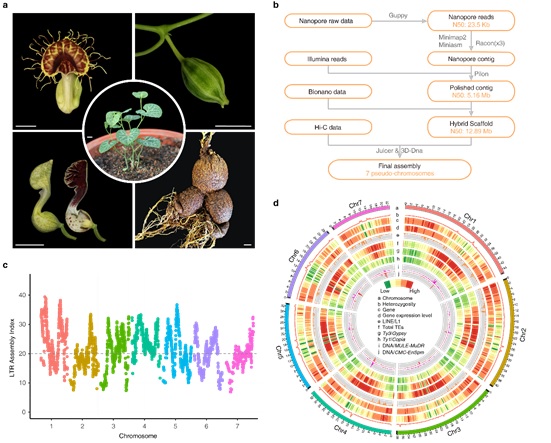A research group led by Prof. JIAO Yuannian from the Institute of Botany of the Chinese Academy of Sciences recently reported a high-quality genome sequence of Aristolochia fimbriata, providing new insights into angiosperm evolution, floral development and chemical biosynthesis.
Relevant results were published online in Nature Plants.
The Aristolochia genus belongs to the order Piperales, which resides within the magnoliids, an early diverging lineage of the Mesangiospermae. This genus has been famous for centuries for its highly specialized flowers and wide medicinal applications.
In this study, the researchers revealed that A. fimbriata is the second genome, among several hundred sequenced flowering plant genomes, that exhibits a lack of any lineage-specific whole-genome duplication (WGD) since the origin of extant angiosperms. The only other is Amborella (the sister to all other living angiosperms).
Using such a reference genome, the researchers were able to identify two overlooked WGDs in Piperales and clarify the time of previously reported WGDs in Magnoliales and Laurales.
“We were surprised about the WGD history of this species,” said Prof. JIAO, corresponding author of the study. “It offers a truly exceptional reference genome for other comparative genomics and evolutionary studies in flowering plants.”
The researchers, using this outstanding reference genome, identified a shared, chromosomal arrangement event in magnoliids and monocots that was missing in eudicots. This finding suggests that the magnoliids and monocots are sister clades, with eudicots as their sister lineage.
The scientists faced a challenge in resolving the relationship among these three clades using phylogenetic inferences based on sequence data. However, by studying genomic structural variations, they were able to overcome the shortage of informative sequence divergence generated during rapid diversification.
The researchers also deciphered the A. fimbriata genome for functional genomics studies of its highly specialized flower development and natural product biosynthesis.
By identifying associated homologues and investigating their evolutionary histories and expression patterns, the researchers revealed highly-conserved floral developmental genes and their distinct downstream regulatory network that may contribute to the complex flower morphology in A. fimbriata.
They also reconstructed the complete Aristolochic Acid I biosynthesis pathway and identified the molecular basis underlying terpenoid and aristolochic acid biosynthesis in A. fimbriata.

Overview of the A. fimbriata genome assembly and features. (Image by IBCAS)
Article Link: https://www.nature.com/articles/s41477-021-00990-2
Contact:
JIAO Yuannian, the Institute of Botany, CAS
Email: jiaoyn@ibcas.ac.cn
A research group led by Prof. JIAO Yuannian from the Institute of Botany of the Chinese Academy of Sciences recently reported a high-quality genome sequence of Aristolochia fimbriata, providing new insights into angiosperm evolution, floral development and chemical biosynthesis.
Relevant results were published online in Nature Plants.
The Aristolochia genus belongs to the order Piperales, which resides within the magnoliids, an early diverging lineage of the Mesangiospermae. This genus has been famous for centuries for its highly specialized flowers and wide medicinal applications.
In this study, the researchers revealed that A. fimbriata is the second genome, among several hundred sequenced flowering plant genomes, that exhibits a lack of any lineage-specific whole-genome duplication (WGD) since the origin of extant angiosperms. The only other is Amborella (the sister to all other living angiosperms).
Using such a reference genome, the researchers were able to identify two overlooked WGDs in Piperales and clarify the time of previously reported WGDs in Magnoliales and Laurales.
“We were surprised about the WGD history of this species,” said Prof. JIAO, corresponding author of the study. “It offers a truly exceptional reference genome for other comparative genomics and evolutionary studies in flowering plants.”
The researchers, using this outstanding reference genome, identified a shared, chromosomal arrangement event in magnoliids and monocots that was missing in eudicots. This finding suggests that the magnoliids and monocots are sister clades, with eudicots as their sister lineage.
The scientists faced a challenge in resolving the relationship among these three clades using phylogenetic inferences based on sequence data. However, by studying genomic structural variations, they were able to overcome the shortage of informative sequence divergence generated during rapid diversification.
The researchers also deciphered the A. fimbriata genome for functional genomics studies of its highly specialized flower development and natural product biosynthesis.
By identifying associated homologues and investigating their evolutionary histories and expression patterns, the researchers revealed highly-conserved floral developmental genes and their distinct downstream regulatory network that may contribute to the complex flower morphology in A. fimbriata.
They also reconstructed the complete Aristolochic Acid I biosynthesis pathway and identified the molecular basis underlying terpenoid and aristolochic acid biosynthesis in A. fimbriata.

Overview of the A. fimbriata genome assembly and features. (Image by IBCAS)
Article Link: https://www.nature.com/articles/s41477-021-00990-2
Contact:
JIAO Yuannian, the Institute of Botany, CAS
Email: jiaoyn@ibcas.ac.cn
